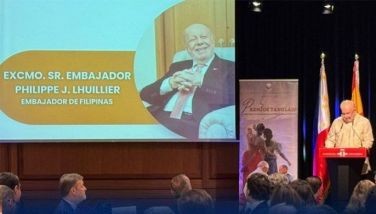Traffic jams: A sign of progress?

XIAMEN – Maybe P-Noy got it right. Traffic jams could be a sign of progress. Every city we visited in China this week had some traffic jam to delay our travel, test our patience... and progress was visible everywhere. We landed in this port city close to six in the evening and ended up having to bear their rush hour traffic jam.
Then again, China is now the world’s largest car market. The feverish construction of China’s road infrastructure network, which was the envy of every Filipino in our group, still can’t seem to cope with the volume of traffic that just grows and grows.
I was last in Xiamen about eight years ago and the fast development of public infrastructure is very obvious. Like most of China’s other major cities, Xiamen has excellent road, rail, air and port infrastructure now in place.
The new thing in Xiamen since I last visited is the Bus Rapid Transit system. This BRT is different from most if not all other BRTs elsewhere in the world --- it is elevated. It features a dedicated bus-only closed road system with stations and ticketing system similar to light rail.
Indeed, I was told that they really wanted a LRT system similar to ours but the central government in Beijing disapproved it because the population of Xiamen at that time was not big enough. City and provincial planners however wanted to put up a mass transit system.
So they put up the elevated carriageway that would be good for two LRT tracks, for future use. But they decided to put a bus system instead, and to me it made a lot of sense.
The BRT network is simply bus lanes with no traffic lights and travel speed is limited by design to 60 kilometers per hour. Xiamen’s BRT uses dedicated elevated roadways as well as dedicated lanes on bridges. The system is now 115 kilometers long. There are now five BRT routes in service. A commuter can expect a BRT bus every five minutes.
I am told that the system is not adequate during rush hours. Xiamen eventually received approval from Beijing to build a subway system too. Xiamen Metro has been under construction since 2013 and the first line should be operational by 2017. Three lines have been approved and they are planning to have a total of six lines.
Imagine that they are making all that infrastructure investment for a city with a population of just 3.5 million based on the 2010 Census. But even if the population of Greater Xiamen is now close to five million, that’s just Quezon City and City of Manila with Mandaluyong and Makati thrown in. We are a metropolis of 10 million and we are just making do with our ad hoc transport “system” of jeepneys, buses and UVs.
The dynamism of Xiamen can be felt by the visitor. This is not surprising. Overseas Chinese communities in Southeast Asia started off from the port of Xiamen, then known as Amoy. Life was tough in this part of China with the soil not as fertile as that near the big river systems. They had to go abroad for a living.
This included the Filipino Chinese taipans from Henry Sy, to Lucio Tan and John Gokongwei’s father. But, I am told Gokongwei is on a different class. His ancestral house is still there in Gulangyu Island, said to be the Forbes Park of Xiamen.
But most of the migrants who passed through Xiamen’s port were impoverished folks from around Xiamen and adjoining provinces. This included Liem Sioe Liong, the founder of the Salim Group that beneficially owns PLDT/Smart through First Pacific in Hong Kong.
As we passed downtown Xiamen, we noticed a big construction project with the sign identifying it to be owned by Eton, the Lucio Tan brand name for his property investments in China. Another big piece of prime property nearby is said to belong to Gokongwei, but no construction activity was evident. A very modern SM City is a very impressive landmark somewhat away from the city center but perfect for the upwardly mobile middle class families.
A Manila visitor will also be delighted to see an attempt to preserve Xiamen’s old buildings in the central part of the city. It is also surprisingly clean, something hard to imagine for those of us who are used to Binondo and its filth.
One key road in the old city center was cleared of motorized traffic. The pedestrian only rule created a festive tourist-oriented atmosphere that boosted businesses in the area.
I noticed a determined effort to more carefully plan the city with wider avenues and more greenery. There is the attempt to soften the harshness of concrete with clinging ivy on the BRT structure. Surely, their overpasses (and they have plenty) look more pleasantly clean than ours.
And speaking of the BRT, what they did in Xiamen is a good idea. In fact, last May I proposed doing something like that to replace the dangerously dilapidated MRT 3. Running buses on the carriageway that now carries MRT trains on tracks is probably a quicker and more cost effective solution to the MRT problem.
Anyway, if we know what we are doing to protect life and limb, we ought to discard what we have now and start from scratch. Why put in the same system that is expensive and requires a lot of foreign technology? Actually, Science Secretary Mario Montejo had the right idea when he decided to test a similarly elevated BRT system at UP campus.
I asked the group of Francis Yuseco Jr, a proponent of the BRT system, to crunch some numbers to see how feasible that idea is. What they came up with seems promising.
Francis says replacement of the existing MRT line is doable, cheaper and easier to do than even waiting for the new Chinese rail cars to be delivered. Francis said his engineers “estimate the dismantling, reconstruction and rehabilitation will cost P20 million per kilometer for both lanes totaling 3.5 meters per lane. Thus, for a 22-kilometer elevated carriageway as in the EDSA MRT, the total rehabilitation and reconstruction costs for the elevated carriageway will be a very manageable P440 million.
“The coaches carrying 200 passengers each will cost P12 million each. Say, we start with 100 coaches or 50 coaches per direction, plus your command center of P50 million incorporating your pre-board contact less system, plus miscellaneous and contingent costs of another P50 million, we’re looking at a total replacement cost of roughly P1.8 billion.”
Best of all, Francis claims they can make the BRT operational in eight months. “Using the numbers made by the UPTTC in 1989, using only 92 coaches, we can transport 1,056,000 passengers a day, about double the current load.”
As I wrote last May in this column when I first broached this idea, I realize nothing will happen, but I thought I could help by offering fresh ideas, seeing that there is hardly any thinking or action of whatever kind coming out of DOTC. The DOTC Sec is too busy playing Liberal Party politics.
While I was away, Dax Lucas of Inquirer reported that “SMC chief Ramon Ang, the conglomerate —which is currently building the Skyway stage 3 elevated roadway that will link Sen. Gil Puyat Ave. in Makati to Balintawak in Quezon City — was looking at plans to set up an electric bus-based mass transit system atop the Skyway.
“Instead of electric trains, commuters will use articulated buses (which look like two buses joined in the middle by an accordion) and drawing power from overhead electric lines, just like the light rail system. But they will not ride on rails, and will instead be driven on the road.”
Seems I am not the only one who thinks BRT is the better system for our needs. My seeing the BRT as implemented in Xiamen made me realize I was on to a good idea. But the DOTC guys are just too lazy and unimaginative to think in terms of solutions.
It is still an uphill battle even for Xiamen and the important Chinese cities. They can’t build transport infrastructure fast enough to at least alleviate their traffic jams.
As P-Noy said, those traffic jams are a sign of progress. On that count, we are seeing as much progress back home as we saw this week all over China. Anyone who says otherwise is just an incorrigible griper. Right, P-Noy?
Passion
From Joji Villaescusa.
A middle aged couple walking in the park noticed a young couple sitting on a bench, passionately kissing.
“How come you don’t do that?” says the wife.
Husband replies: “Honey, I don’t even know that woman!”
Boo Chanco’s e-mail address is [email protected]. Follow him on Twitter @boochanco
- Latest
- Trending

























